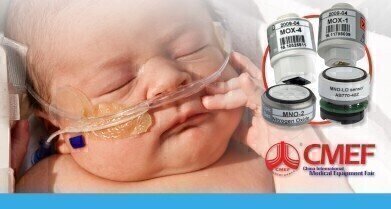Gas sensors
Growth in Asia Pacific Healthcare Creates Increased Demand for Medical Gas Sensors
May 14 2015
Honeywell company, City Technology (UK), a manufacturer of gas sensors, will be showcasing its medical gas sensing range at the CMEF China International Medical Equipment Fair 2015 in Shanghai on 15-18 May, in Hall 6.1, Stand B42. Products on show will include sensors used in applications such as ventilators, anaesthesia benches, incubator systems, respiratory gas monitors and breath analysers.
The decision to exhibit is in response to growth in the medical gas sensing market globally. Although North America continues to dominate with the largest medical gas sensing market share, Asia Pacific is experiencing the biggest total growth, catalysed by increasing healthcare standards in emerging economies such as China, South-East Asia and India.
Robin Barnes, Product Manager for City Technology comments on the company’s growth in this region: “There is an increasing demand for our medical gas sensors in Asia Pacific’s rapidly evolving medical markets. Offering advanced performance and accuracy, we provide sensors for both premium critical care systems and sensors designed to offer increased cost-efficiency for simple hand-held breath analysis instruments. Our growth can be attributed to a combination of industry-leading performance, stability, cross-sensitivity immunity and affordability. With 37 years’ experience leading the gas sensing marketplace, our technologies are well-proven in this field.
“The ISO 80601-2-55 certified MOX range delivers high performance oxygen sensing, with a fast speed of response for respiratory monitoring in ventilation, anaesthesia, breath analysis and neonatal incubation. This range includes MOX-1, 2, 3 and 4, 0-100% oxygen, incorporating advanced design for anaesthesia agent cross-sensitivity immunity (meeting ISO 7767). When cross-sensitivity is not a consideration, the temperature compensated, fast response (less than 1 second) MOX-20 provides the ideal breath monitoring solution, while IN-Q-OX is specifically designed for neonatal incubators, providing long operational life and fast response time.
“Carbon monoxide sensors are used for preventative healthcare, as an indication of CO levels during smoking cessation. The 4LXH has low cross-sensitivity to hydrogen, for enhanced stability and accuracy. Hydrogen monitoring is also important for diagnosing certain gastro-intestinal disorders and lactase enzyme deficiency (causing lactose intolerance). The 7HYT hydrogen sensor offers high performance monitoring in exhaled breath.”
Advances in healthcare in the region are also creating growing demands for nitric oxide and nitrogen dioxide sensors, as Robin Barnes continues. “Nitric oxide is an increasingly important therapeutic agent; especially within pulmonary hypertension treatment for paediatrics and neonatal care. Our MNO series deliver reliable nitric oxide monitoring, with a fast speed of response and immunity to anaesthesia agents, along with the ability to be temperature compensated. During the therapy, nitrogen dioxide toxicity must also be monitored, hence the MND series is the perfect high performance partner to MNO.
“Our ability to offer a full spectrum of features at a low cost of ownership creates an attractive differentiator that will no doubt see our current growth sustained in the region for the foreseeable future.”
Digital Edition
AET 29.2 May 2025
May 2025
Water / Wastewater- From Effluent to Excellence: Microbiological assessment of a containerized modular water reuse pilot system- Without water everything comes to a haltAir Monitoring- Probe Sampli...
View all digital editions
Events
Jun 17 2025 Guangzhou, China
Singapore International Water Week Spotlight 2025
Jun 23 2025 Singapore
Jun 24 2025 Santa Clara, CA, USA
Jun 25 2025 Sao Paulo, Brasil
Jun 28 2025 Albena, Bulgaria



.jpg)








.jpg)






